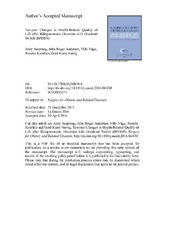Ten-year changes in health-related quality of life after biliopancreatic diversion with duodenal switch
Peer reviewed, Journal article
Accepted version
Permanent lenke
https://hdl.handle.net/1956/15286Utgivelsesdato
2016-09Metadata
Vis full innførselSamlinger
Originalversjon
https://doi.org/10.1016/j.soard.2016.04.030Sammendrag
Background: Long-term data on health-related quality of life (HRQL) after biliopancreatic diversion with duodenal switch (BPDDS) are scarce. The aim of this study was to evaluate changes in HRQL from baseline to 10 years in patients who had undergone BPDDS. Methods: We included 50 patients who underwent BPDDS for severe obesity at Førde Central Hospital in a prospective cohort study. HRQL was measured with a self-report questionnaire, the Short-Form-36. Main outcomes were the physical component score and the mental component score. HRQL was assessed before surgery and after 1, 2, 5, and 10 years. Linear mixed-effect models were applied to evaluate changes over time. Results: A total of 35 patients (70%) completed the 10-year follow-up of the HRQL study. The mean body mass index at baseline was 51.7 kg/m2 (95 % CI, 50.0–53.5) and 34.3 kg/m2 (95% CI, 32.4–36.2) at 10 years. The physical component score improved significantly from 32.6 (95% CI, 29.7–35.5) at baseline to 44.2 (95% CI, 40.9–47.5) at the 10-year follow-up (P<.001). Mental component scores also improved significantly, from 37.8 (95% CI, 34.2–41.3) at baseline to 46.0 (95% CI, 41.9–50.0) at the 10-year follow-up (P<.001). However, the scores at 10-year follow-up were significantly lower than the Norwegian norm data. Conclusion: Ten years after BPDDS, patients’ HRQL was significantly improved from preoperative values, and approximately 60% of the improvements seen at 1-year follow-up were maintained.

